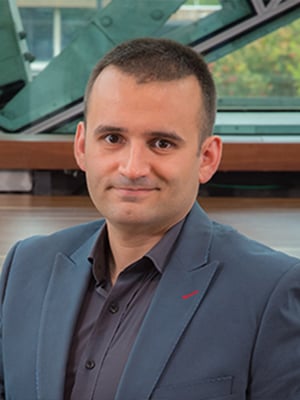One giant leap for microplastics
Research news
Sometimes, in the enormity of the global climate emergency, we forget about the importance of the small stuff.
In this case, it's our microplastics.
With nano and microplastics in our waterways, oceans and water waste Deakin researchers are putting even the tiniest fragments of our waste under the microscope to see their impact.
So, what defines a microplastic?
ARC DECRA Fellow, Dr Ludovic Dumee, from Deakin University’s Institute for Frontier Materials (IFM) explains microplastics are present in many of our everyday possessions.
Primary microplastics can be found in “cosmetic products or additives in materials, designed to be there in a specific shape and size”.
Secondary microplastics are generated by polymeric plastic materials degradation such as plastic bottles and bags when exposed to specific aggressive environments or stress.
It is the breaking down of the plastic in these items that allows them to morph into something smaller and more difficult to avoid.
These materials go from a process of “wearing off and decomposition due to UV, temperature and other biocatalytic reactions which lead to the formation of these microplastics,” Dr Dumee says.
A pair of single use plastic bottles found during a beach cleanup in Barbados.
“A great amount of microplastic is generated from waste discarded improperly into rivers or the ocean.
“This is also present across materials exposed to water, like surface finishes such as paints or coatings, which can wear off and weather quickly.”
It then becomes about looking closer at the products we have in our lives, thinking about their post-consumer life and where they may end up.
The big challenge: detection
Dr Dumee’s and PhD candidate Marie Enfrin recent research in conjunction with Dr Judy Lee from The University of Surrey, ‘Nano and microplastics in water and wastewater treatment processes – Origin, impact and potential solutions’ in Water Research noted that limiting the number of microplastics in water is vital to creating positive outcomes for our waterways.
The question then becomes: how do we reduce plastic entering our water if we can’t see them?
Albeit from the chemical footprint of plastic materials, allowing for specific identification, a key challenge lies in the detection of small, micron sized and smaller, plastic particles.
A second difficulty lies in the composition of the water matrix, corresponding to the list of elements and molecules present in the water.
“Most of the time these microplastics are present in fairly small concentration and are mixed with bacteria, proteins, and other natural organic matters, making their identification even more so difficult.”
All these other composites in the water “represent a larger quantity compared to just the microplastics alone.
“Therefore, one of the key challenges we work to is to either selectively concentrate them [plastics] or reduce the limit of detection of existing platforms.”
Spotting microplastics is not as straightforward as it may appear.
Community education is powerful
The presence of microplastics can often generate concern from people within the community who turn to ask: what can be done to help?
Dr Dumee notes that educating people about how plastic should be sorted can be very effective. Understanding the ins and outs of how we should dispose of our waste could empower consumer to dispose of their plastics correctly.
Our team has done some digging to produce a brief, but my no means extensive guide to yours bins (not including a compost bin – which can be wonderful for your food waste and your garden!):
Red, your household garbage: wrapped nappies, polystyrene foam, unavoidable food waste.
Yellow, your recycling bin: aerosol cans, scrunched aluminium (at least the size of a golf ball), envelopes, glass bottles and jars, plastic, paper, metal, cutlery and pizza boxes without food waste.
Green, your garden waste: prunings, grass, leaves, small branches, weeds and flowers.
If you’re still unsure, it is always best to check out the range of resources available – including local council guidelines and other informative websites.
Some countries have gone further than the three-bin system, even. It is not uncommon in some European countries to have ten plus different bins to use at a recycling centre.
This is because the mixing of glass, plastic, paper and metal among others can have poor implications for reusing our waste.
“It becomes a civic duty of the people. Whereas, in Australia, we are very limited in terms of options.”
Although there have been conversations about changing how kerbside collection works in Victoria, this is not all that needs to be done.
It requires collaboration from the community to dispose of their waste properly, but also, the industries who engineer these materials.
Re-engineering materials for the planet
Plastics are closer to us than we first thought, literally.
“There is evidence now that plastics are being found in human blood, so clearly, there are some pathways for them to diffuse into different parts of the organism,” Dr Dumee explains.
It seems finding new ways to create materials that limit the use of plastic is the next step moving forward to benefit the health of our ecosystems.
It is difficult to say if plastic will ever become a thing of the past – but there is some thinking that needs to be done for the future.
To expand on the research of the time, some education is required not only for consumers but for industries too.
“It is important at the global level right now for researchers to try to better map the extent of pollution, to improve understanding about the routes leading to release of these microplastics.”
“One field of which could be used for such purpose includes the re-engineering of the materials to make them more resilient and to prevent contact and release of microplastics into our waterways and water supply.”
Discarding our waste properly is one thing.
Making our products differently might be the big step forward we need to limit microplastics.
Written by Deakin Research, disruptr
Share this story

Key Fact
Dr Ludovic Dumee
